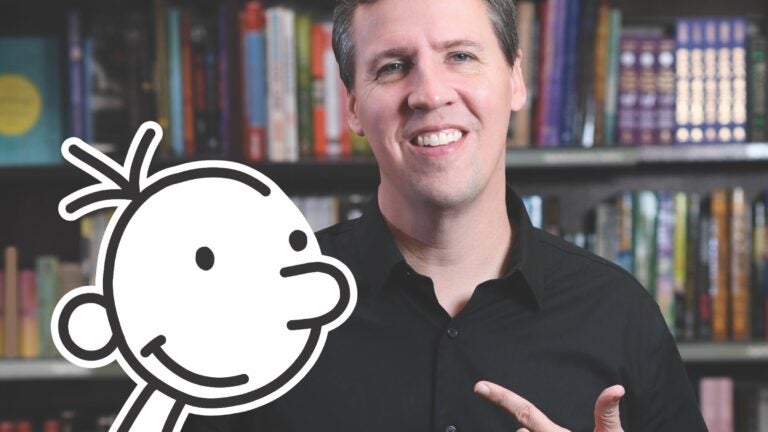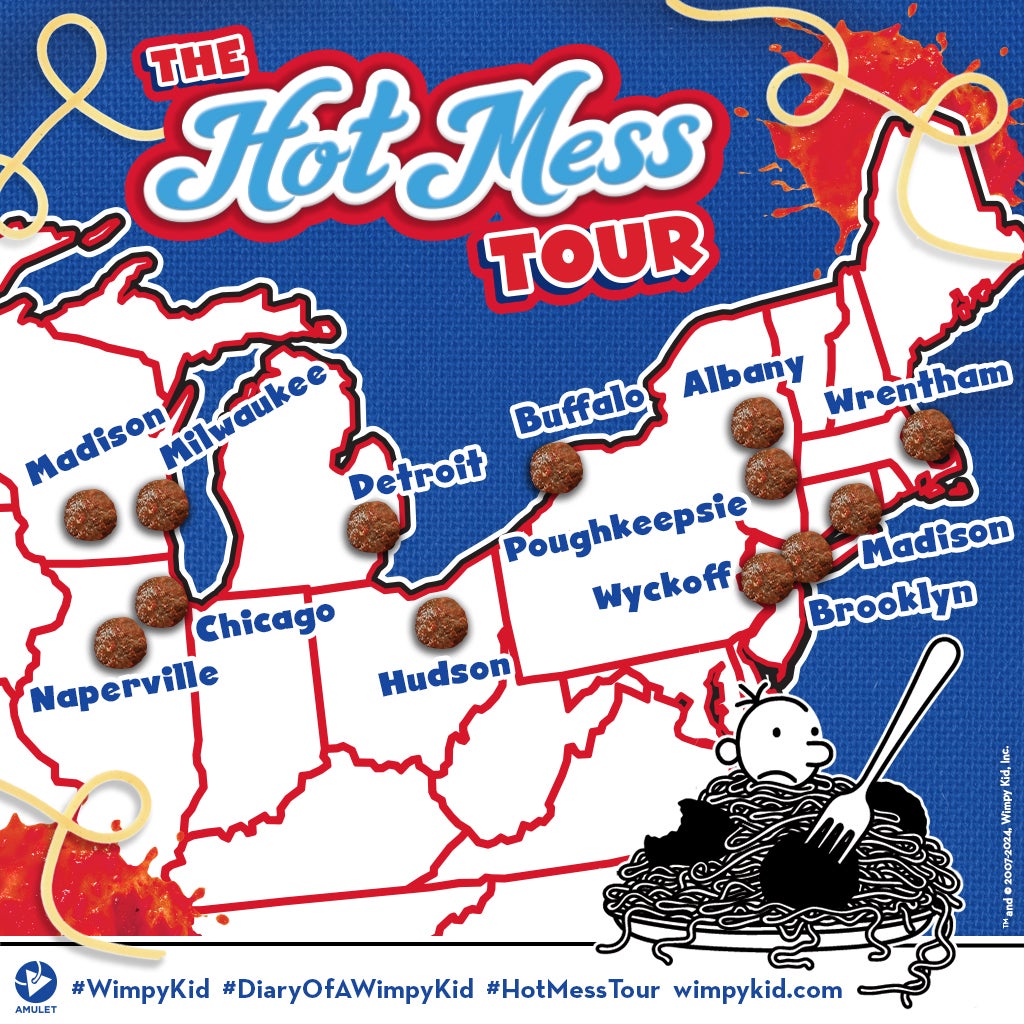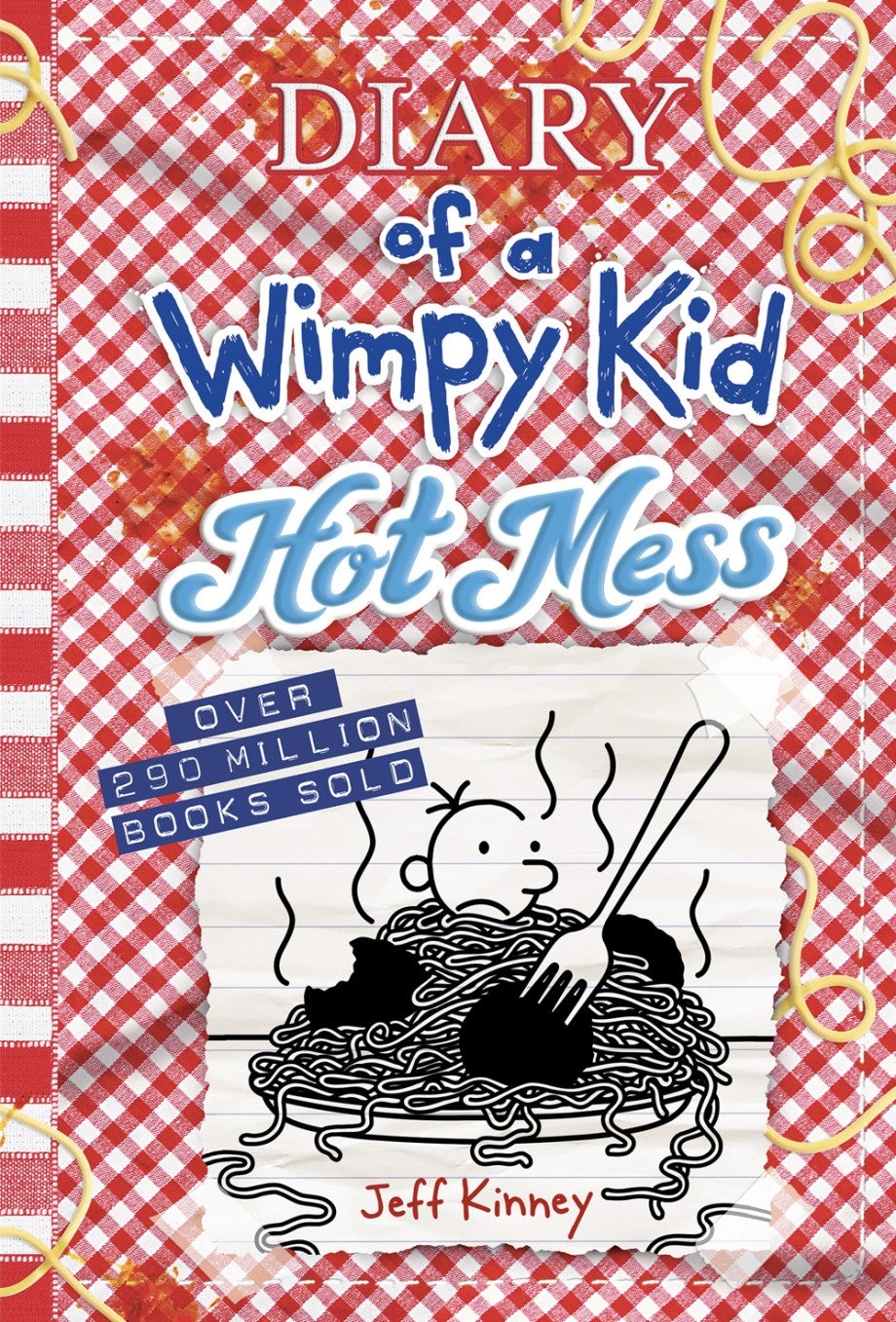No products in the cart.

‘Diary of a Wimpy Kid’ author Jeff Kinney: The Boston.com interview
Between writing “Wimpy Kid” books and operating his Plainville, Massachusetts, bookstore, Jeff Kinney is still the hardest working man in children’s epistolary novels.

Jeff Kinney has 290 million books in circulation right now. That’s a lot of books. Like, a John Grisham-level number of books.
But unlike Grisham, Jeff Kinney’s “Diary of a Wimpy Kid” books are filled with hilarious cartoons that he draws himself. And also unlike Grisham, Kinney, 53 — who could clearly be living on a beach somewhere, spending whatever royalties one receives from selling 290 million books — gives back every day to his town of Plainville, Massachusetts, via his community bookstore, An Unlikely Story. (Not to disparage Grisham, who may very well be doing fine things wherever he lives.)
Advertisement:
Kinney’s own story would definitely qualify as unlikely: A self-described failed cartoonist, he spent eight years developing his first “Wimpy Kid” novel after syndicates passed on his daily comic strip. And within a few years after that came out in 2007, he found himself with a hit book series and a movie in the works (the first of many), and he’s since become the steward of a worldwide franchise that shows no signs of abating.
And while he may not be a Bay Stater by birth — he hails from Maryland originally — he’s more than made Massachusetts his natural habitat. “Here I felt that sense of home that I didn’t really feel back home,” Kinney said in a recent interview from the studio in his Plainville store, explaining that after winding up here basically by chance, he made it a point to dive in with both feet.
Advertisement:
“I became a Celtics fan when I moved up here because I decided to be one. I was like, I’m going to fully integrate myself into the community,” he recalled. “I just wanted to feel like a part of the community.”
In the middle of an international tour following the publication of his 19th “Wimpy Kid” book, “Hot Mess,” Kinney sat down for a wide-ranging interview about his love of comic strips, where “Wimpy Kid” came from, how he wound up in Massachusetts, his input on the “Wimpy” movies, and much more.
Questions and responses have been edited for length and clarity.
Boston.com: You’re in the middle of a big tour right now. I’m picturing a giant jet with the Wimpy Kid logo on it. What does a tour entail for you?
Jeff Kinney: Well, I drive a Sprinter, so I think we have to take it down a few notches. [laughs] I drive like an oversized, customized Sprinter that’s wrapped in the Wimpy Kid color scheme and everything. And then I’m flying over commercial to China, Japan, South Korea, and Taiwan on my next leg. So the van is the part that’s wrapped, the plane is not.
What have you seen from audiences on this most recent tour here in the U.S.?
Jeff Kinney: You know, it’s really cool. We played in theaters where it was about 1,000 people a night, and I always started off every show with the same thought, which is that I can’t believe, after 17 years of doing this, that my books are finding a new audience, that this was not the generation that I wrote for originally — those guys are 25 years old now. Jayson Tatum‘s age, basically. [laughs] And so this is the new crew, you know. And so it’s really cool for me to see the full breadth of the readership. Like last year, we unveiled a statue of [main character] Greg Heffley at my alma mater, the University of Maryland, and for the first time ever I saw the whole span of readers in one place, from 8 years old to about 25, 26 years old, and it’s cool to see the people who your work has impacted. It’s a tremendous honor.

Were you given any instructions or limitations for your talk in China?
Jeff Kinney: That’s really interesting that you’d ask that. I haven’t been given any limitations. I do sort of have a general sense that, you know, I probably should stick with the comics. But everywhere I go there’s like a person in military garb that’s attending as well [laughs], so I’m sure there’s a little extra [influence] there.
Advertisement:
But I think that honestly what touring all over the world has taught me is that we, human beings, we all have this thing in common, our childhood. You know, we have parents and bullies and teachers and pets and homework assignments and pop quizzes, and all these things that make up the fabric of the Wimpy Kid universe. And you know, for all the differences that people have across the world, kids are more or less the same. It’d be really hard for me to know where I was if I couldn’t see the kids. If I could just kind of feel the reaction of the kids, whether it be Brazil or New Zealand, or wherever I am — it feels like kids are sort of experiencing the books in the same way, and it gives me a little bit of hope.
So you’re on, what, the 16th book now? I’ve lost count.
Jeff Kinney: Believe it or not, it’s the 19th book. And so I’m coming up on the 20th. And I feel as energized about the 20th book as I do about anything. Usually there’s some aspect of childhood that I haven’t explored yet. This last book is called “Hot Mess,” and it’s about the extended family vacation where you’re mixing with your cousins and aunts and uncles in a too-small place … I think a lot of kids kind of know what that feeling is like. And my next book is going to be really centered around birthdays. And, you know, every kid has a birthday right? So I keep finding these pockets that I can fully explore. And so maybe one day I’ll run out of pockets or topics, but so far I haven’t, and that makes me feel like I could do this for a while.

Greg is basically the same age as when the books started, right? We won’t be seeing him going to high school and college.
Jeff Kinney: No. And that’s the language of cartoons. And I think I really came to fully understand it during COVID, which is that the promise of a cartoon character is that they won’t change. When we think of Calvin and Hobbes, or Peanuts, or any number of other long-lasting comics, they’re a security blanket in a way. It’s like baseball. That is, as radical as the changes we can go through are, this one thing will stay the same.
Advertisement:
And I’m thinking that, especially in our time of real political tumult, in which half of the country is profoundly unhappy right now, at least there’s this. Maybe this is something I can add to the world, this feeling of constancy and a feeling of “un-change.” So that’s what I think cartoon characters do.
Let’s go back to when you first came up with this idea, which essentially wound up creating an entire new sub-genre of publishing. Was the idea gestating for a long time, or did it sort of come to you fully formed?
Jeff Kinney: Well, being a cartoonist, having a comic strip was my aspiration, and I failed to achieve it. I know, play me the world’s smallest violin. [laughs] But that was what I wanted to do. When I grew up I read the Washington Post. Every day there were a few comics that I liked to read, and I could see for sure that that’s where I wanted to be, and I thought I had the comedic chops to do it. I felt like my joke writing was strong, but I knew that I was not a fine artist. If you look at Schulz and Watterson, and many others, they are also fine artists — like, you know, Burke Breathed and Garry Trudeau. I don’t think Gary Larson really was a fine artist, but his art style really worked for his humor style.
So I’ll cut to the chase. I wanted to be a newspaper cartoonist. It didn’t work out for me. I tried for about three years. Then I had this idea of embedding my comics into a journal format. I worked on it for eight years. I really took my time. I wrote ideas for four years, and I wrote the first draft of the manuscript for four more years, and then I was finally ready to show it to someone. So it took me a really long time to develop it. I knew it was going to be my opus, you know, win or lose, that this was going to be the best that I could do. And I feel really lucky that it worked out.
What were the comic strips and characters you glommed onto growing up?
Jeff Kinney: I would say anything that had clean lines, when I saw a lot of white space and clean lines. So my eyes always went right to Beetle Bailey, and comics like that. Peanuts was always at the top of the page, and that was a fabric of all of our growing up years, of course made especially strong because of the [TV] specials … And then I did like Calvin and Hobbes. I think The Far Side might have been one of my very favorites and I really liked Bloom County for a while there, too.
Advertisement:
And then Big Nate came along when I was about 19 years old, and I wrote to the creator, whose name is Lincoln Peirce, and I said, hey, I want to become a cartoonist. Here are my cartoons. What can you tell me, how can I get better? And he gave me really good advice and in fact, our friendship has persisted through all these years, and eventually I helped get his cartoons into books. So I was trying to get into the field that he was in, which didn’t work out. And then eventually he wanted to get into the field that I was in, which did work out for him, so I guess he won twice. [laughs]
You started out in Maryland — how did you end up in Massachusetts?
Jeff Kinney: First marriage is my short answer. I was married for a short time, I think, three years total. I’m happily in my second marriage right now, 24 years and counting. So I came up here, my first job was at a little paper in Newburyport, called the Newburyport Daily News. I got to be a graphic designer, and I stuck around, and I found a home here. I feel like New England was really where I belonged. I never really exactly felt like I belonged where I grew up.
And now you’re in Plainville, where your bookstore is. But it’s far from just a bookstore. Why has it been important to you and your wife, Julie, to give back to the Plainville community, which is such a huge part of what you’re doing down there?
Jeff Kinney: Yeah, it started with, we had this kind of dead downtown. There were just a few businesses downtown, a lot of empty or hollowed-out buildings. There was an abandoned building called Falk’s Market, which had been closed for 17 years by the time we bought it, but it used to be the hub of the community, this market. By the time we got there, it was kind of a sad reminder of the glory days of the downtown. And so my initial goal was just to buy it and turn it into a nice building, because I thought that it would go a long way towards the town’s self-esteem to have a nice building with the word “Plainville” written on the side of it.
Advertisement:
After that we were like, well, what should we put inside of the building? And we decided that a bookstore was a good idea, because it could serve everyone from ages 2 to 98. And it has, you know, it really has, and we’ve brought in really the best authors in the world here over the last nine years, and it’s cool, you know? You’ve got luminaries like Chelsea Clinton, or Henry Winkler, or Rick Riordan, Dave Pilkey. All these people coming to Plainville, Massachusetts. And that’s just because we made a building.
And you also have events, right?
Jeff Kinney: Yeah, we do just about everything here. We have trivia on Friday nights occasionally, and then we do all sorts of things, like yoga and arts and crafts … Sometimes we bring in a giant, inflatable humpback whale that kids can crawl inside of. It turns out there are a lot of things that you can do with a building. And I remember years ago, when I was a budding Celtics fan and Shaquille O’Neal came to the Celtics, and I was like, oh, this is cool. I’m going to get to meet Shaquille O’Neal, and then I was like, well, why? Why would I get to meet Shaquille? I’m like [just] a guy, you know, a fan, or whatever. And what’s funny is, having a building changes everything. For example, a few weeks ago, we had Jayson Tatum. And it’s only because we built a building. Everybody needs a place to be, you know? So it’s like a magnet for people like that.
I wanted to talk a little bit about the movies — what is your input on those projects like? Are you involved with the planning and the production?
Jeff Kinney: Yeah, it’s been complicated and ever-changing. I would say that where I am right now is that I’m working on the Disney+ movies, and those are animated, and I am involved in every pixel of those things. Like, I’m the writer, I’m the producer, we have meetings several times a week. I’m in all the casting, like whenever we’re recording a cast member I’m in it. I’m giving the cast members lines, blah blah blah. So as fully involved as a creator can be. That’s how involved I am in those movies.
Advertisement:
In the live action movies, I was a baby writer, you know? I had only just put out my second book when the movie deal came through, and I did not know anything about screenwriting or movies or anything like that. So I didn’t have an opportunity to write those scripts. Eventually, over time, I got myself in a position where I took a crack at it, but I was learning the movie business at that time. That being said I was, you know, there on set almost every day, or at least half the time, and I was kind of very peripherally involved, and every so often they’d need a line, or they’d need me to write lyrics to a song, or something like that. “Explöded Diper,” I’m the credited writer on that one. [laughs]
If you’re a creator, what typically happens is that you’re saying, I have this idea. I have this thing. Now, you guys make it into a movie because you guys know how to do movies. And there’s not really a role for the creator, and I was lucky, you know, that they wanted me around, or they tolerated me being around. But it’s a touchy business, right? A creator can cause a lot of problems for the film … so it’s sometimes better for the studio to keep an arm’s-length distance.
It’s changed with streaming, because now they really want the creators to be involved because they want to capture that thing, the thing that made it work on the page. They want to capture it on the screen, and so writers are in a much better position. Authors are in a much better position in this world.
What else do people need to know about Wimpy Kid world? What is on the horizon?
Jeff Kinney: Yeah, there’s a musical floating around out there right now — it’s probably being performed in like 40 different places — that’s really good. It’s really, honestly, better than my books. It’s, I think, the best thing in the Wimpy Kid world. And it’s really cool to me that there are these kids all over the country performing this thing right now, and they’ve really captured the essence of the characters. And the songs are really great. So that’s really appealing to me.
Advertisement:
We’re working on more Disney+ movies, hopefully multiple. And then I’m working on my 20th Wimpy Kid book, and even another spinoff is coming up too. So the Wimpy Kid world will go on, and no matter how much our country changes or the world changes, I hope to be doing this for a while.
Note: Dave London also contributed to this article. For the complete interview with Jeff Kinney, including a conversation about his drawing style, methods, and tools, listen to the latest episode of Strip Search: The Comic Strip Podcast below:
📚 Stay up-to-date on the Book Club
Catch up on the latest Boston.com Book Club pick and join the virtual author discussions.






